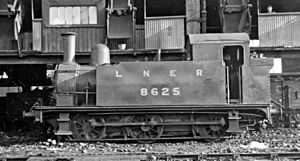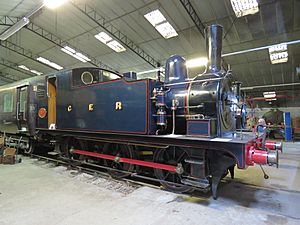GER Class S56 facts for kids
Quick facts for kids GER Class S56 (and R24 rebuilt)LNER Class J69 |
|
 |
|
| LNER 8625 (ex-7059, exx-GER 59) at Stratford locomotive depot, 28 September 1946 | |
| Power type | Steam |
|---|---|
| Designer | James Holden |
| Builder | Stratford Works |
| Build date | 1904 (new) |
| Total production | 20 (new) |
| Rebuild date | 1902–1921 from Class R24 |
| Configuration | 0-6-0T |
| UIC classification | C n2t |
| Gauge | 4 ft 8 1⁄2 in (1,435 mm) standard gauge |
| Driver diameter | 4 ft 0 in (1.219 m) |
| Wheelbase | 13 ft 10 in (4.22 m) |
| Length | 27 ft 8 in (8.43 m) |
| Locomotive weight | 42 long tons 9 cwt (95,100 lb or 43.1 t) |
| Fuel type | Coal |
| Fuel capacity | 2 long tons 10 cwt (5,600 lb or 2.5 t) |
| Water capacity | 1,200 imp gal (5,460 L; 1,440 US gal) |
| Boiler pressure | 180 psi (1.24 MPa) |
| Fire grate area | 14.5 sq ft (1.35 m2) |
| Heating surface: Total | 996.17 sq ft (92.547 m2) |
| Cylinders | Two, inside |
| Cylinder size | 16.5 in × 22 in (419 mm × 559 mm) |
| Tractive effort | 19,091 lbf (84.92 kN) |
| Power class | BR: 2F |
| Nicknames | Bucks, Buckjumpers |
| Axle load class | LNER/BR: RA 3 |
| Retired | 1940–1962 |
| Disposition | One preserved, remainder scrapped |
The GER Class S56 was a type of 0-6-0T steam train designed by James Holden. It was built for the Great Eastern Railway. These trains, along with some similar ones called GER Class R24, later became known as the J69 class. This happened when they joined the London and North Eastern Railway in 1923.
History of the J69 Trains
The Class S56 trains were an improved version of an older type, the Class R24. They looked almost the same but had stronger boilers and bigger water tanks. Twenty of these new S56 trains were built in 1904 at Stratford Works.
All twenty S56 trains became part of the LNER in 1923. During World War II, in 1939, thirteen J69 trains were loaned to the War Department. Five of these were originally S56 trains. They were later sold to the War Department in October 1940. These trains were then used on military railways like the Melbourne and Longmoor Military Railways.
The trains that stayed with the LNER were given new numbers between 8617 and 8636. Some numbers were skipped for the trains sold to the War Department. When British Railways took over in 1948, these trains got new numbers again, starting with 60000.
These trains were slowly taken out of service starting in 1958. By 1962, all of them had been retired. This means they were no longer used on the railways.
Preservation
One of these special trains, GER number 87, has been saved! It was known as LNER 7087, then 8633, and finally BR 68633. This train was first kept at the Clapham Transport Museum. Now, it is part of the National Railway Museum collection. You can see it on display at the Bressingham Steam Museum.


